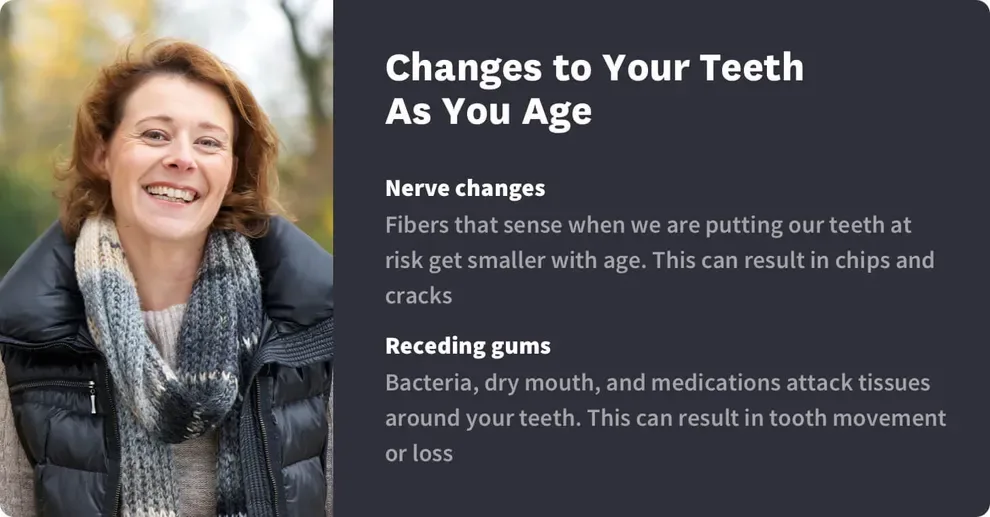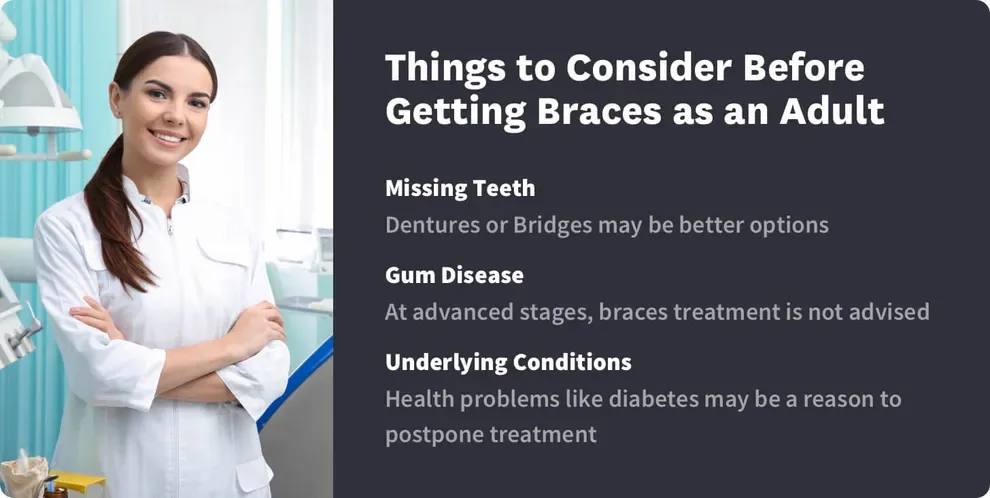Age Limits for Braces: How Young & How Old?

Table of Contents
- Teeth in Childhood
- Teeth as You Age
- How Old Is Too Old
- Aligners Fitting In
- What Adults Should Know Before Getting Braces
- Differences in Adult Treatment
While there’s no set age limit (upper or lower) on orthodontic treatment, there are some general limitations.
For children, treating an orthodontic issue may be easier, as the teeth and jaw are still developing and are therefore easier to influence. In general, orthodontists recommend that people see the orthodontist at age 7 for their first appointment. Orthodontic accessories like a retainer or headgear may be used to correct issues.
For braces and aligners, many orthodontists may recommend waiting until permanent teeth are in before starting treatment. This is usually around age 13.
For older adults, there is no upper age limit on braces. However, if oral health has declined with age, there may be issues that need to be addressed before starting braces or aligner treatment. Missing teeth, for example, would need to be replaced, so teeth don’t have space to shift after correction. The mouth and gums must also be strong and healthy enough to support the teeth as they are moved.
Let's dive into the details about how your teeth change throughout your life, and we'll end with more specifics about the age limits for braces.
Your Teeth in Childhood
We're not born with teeth filling up our mouths. Babies get their nourishment through suckling, and teeth would interfere with that process. But as we age, we develop two sets of teeth. Our two sets of teeth include the following:
Baby teeth: Young children have 20 teeth, 10 up top and 10 below. The roots dissolve, and they become loose within the mouth and eventually fall away.
Adult teeth: By age 13, most people have 28 teeth. These are the teeth that should stay with us throughout life.
Between ages 17 and 21, some of us develop yet another set of teeth. This last set of four molars sit far back in the mouth. These wisdom teeth aren't present for everyone, and they're not typically considered part of our set of permanent or adult teeth.
Each tooth type does something a little different.
Incisors sit at the front of your mouth, and they chop your food into tiny chunks.
Canines sit next to your incisors, and they help to break apart meats and other chewy foods.
Premolars sit beside your canines, and they grind and crush food.
Molars are located at the back of your mouth, and they grind up food even more so it's safe to swallow.
You need all of your teeth to eat food safely without choking or gagging. And they all work together, in perfect unison. They should all be aligned too, so nothing gets caught between them with each bite.

Your Teeth as You Age
You're only given one set of permanent teeth (hence the name). In a perfect world, they'd stay in your mouth for the rest of your life. But health issues are common as we add more candles to our birthday cakes.
As you age, you might deal with:
Nerve changes. We rely on sensory information to tell us if we're putting our teeth at risk. But those fibers get smaller as we grow older, and that means we could miss out on cues that we're harming our teeth. Chips and cracks could form as a result.
Receding gums. Bacteria, dry mouth, and medications can all interconnect and attack the tissues around your teeth. When that happens, your smile might feel wobbly and unstable. You may even lose a tooth or two.
Underlying conditions. Your risk of problems like oral cancer increases with age.
Some people sail into their senior years with a mouth filled with perfectly healthy teeth. But it's clear that you will face mounting challenges to your oral health as the years pass.
In most cases, you must have all of your permanent teeth to get braces, and you must have good oral health to get through treatment.

How Old Is Too Old?
There is no set upper limit for braces. Anyone with permanent teeth in place can sign up for smile-straightening procedures.
But health issues can keep orthodontists from working on your smile. You might face rejection if you are:
Missing many teeth. An underlying condition that causes tooth loss should be addressed before you start therapy with braces. Sometimes, it's easier for older adults to move on to dentures or bridges instead.
Living with advanced gum disease. Infections and other transient gum problems can be addressed. But if your gums peel away from your teeth, the damage can be permanent. Your doctor may not have enough healthy tissue to move you through treatment with braces.
Treating an underlying condition. Some health problems like diabetes don't impact your teeth directly. But they can increase your risk of complications, including problems caused by open sores and bleeding. If your health isn't ideal, your doctor may suggest that you get better before you try braces.
Plenty of older people get braces. Many of them are repeaters. They had braces as younger people, and they need a touchup to pull their teeth back into the right position.
But if your health is not ideal, or you're facing another underlying condition, braces might not be right for you.
How Do Aligners Fit In?
If braces aren't right for you, clear teeth aligners might be a better choice. But you'll face many of the same age limitation issues. Aligner companies, just like those that deal with braces, will want all of your permanent teeth in place before they start work. And if you're an older adult, aligner companies will want to ensure that you're in good health before treatment starts. Some aligner providers, like Byte, offer an at-home impression kit to see if you’re a candidate for aligners. If it’s determined aligners won’t work for you, they’ll refund you for the kit.Byte works hard to remove barriers to treatment. But people should be at least 14 years old before treatment starts. You'll also be asked questions about your health to ensure treatment is right for you.Start with a 30-second online assessment to see if aligners will work for you.
What Adults Should Know Before Getting Braces
Even if you had braces as a child, your teeth can shift over your life and lead to dental misalignments.
This problem not only gives you a crooked smile, but it can also result in underlying dental problems like gum disease, tooth cracking or chipping, or even tooth decay. Misaligned teeth might make you embarrassed to smile in photos, but more importantly than that, they can harm your oral health.
Fortunately, orthodontics like braces can improve your smile regardless of age. Although orthodontics treatment is simpler in children or adolescents, whose jaws and teeth are still growing, dentists can still realign your teeth in adulthood.
Differences in Adult Orthodontic Treatment
There are some differences in orthodontics treatment in adults compared to children. Here are the major points to consider:
Since adult teeth are permanent, and adult jaws and facial structures have finished growing and changing, orthodontic treatment with braces, retainers, or other devices can take longer to work. If you have underlying oral health issues, these will need to be resolved before you can get braces, which can add some time to the overall alignment process.
Dental insurance covers braces for children, but it rarely covers braces for adults. Braces are more than cosmetic for many children who need them, but they are considered cosmetic changes for adults. If you have serious dental health issues, your orthodontist might be able to argue that your health relies on getting braces or undergoing related orthodontics treatment, but this is rare.
Fortunately, many orthodontists have payment options and plans, so you can get the treatment you want. Additionally, more at-home options like mail-order clear aligners are improving access to inexpensive, effective orthodontics treatment.
Children can have cavities or other issues with their teeth, but adults are more likely to have missing teeth, implants, sensitive or damaged teeth, habits like smoking, or other issues that can make orthodontics more complicated. While orthodontists can overcome these issues, it might change which appliances they recommend to align your smile.
Many adults had large metal bracket braces when they were children and are not looking forward to reliving that experience. However, advances in orthodontics have led to numerous options for adult braces that are faster, more effective, and harder to see.
One of the most popular options is clear plastic aligners, which are nearly invisible. Other options include lingual braces (on the back of the teeth) or ceramic braces (which are white to match your tooth color).
If your dentist recommends braces or if you simply want a smile you love, you can get a referral to an orthodontist and discuss options for the best orthodontic appliances to suit your needs. You can also investigate at-home aligners. Most people are great candidates for clear aligners, so more adults are getting important orthodontic help without a mouth full of metal brackets.
